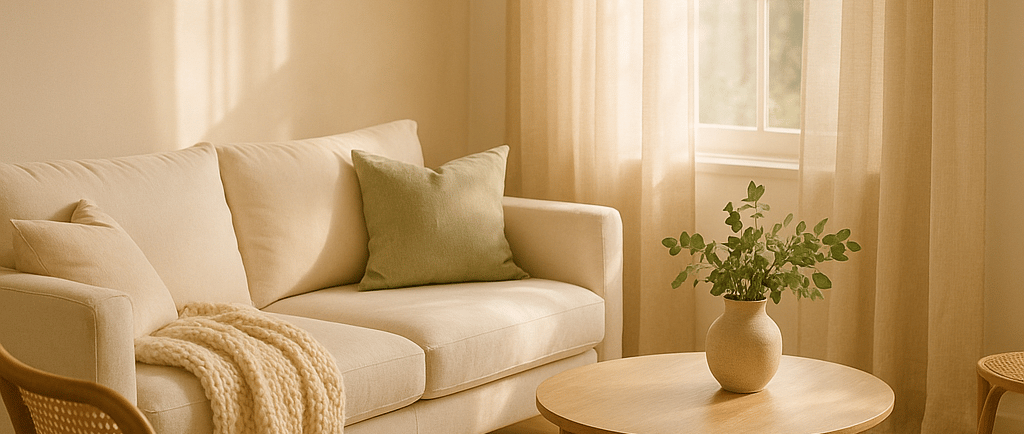The Art of Everyday Calm: Designing Spaces That Feel Like a Hug
11/11/20257 min read


Introduction: The Quiet Magic of a Calming Space
There’s something undeniably powerful about walking into a space that instantly makes your shoulders drop.
Maybe it’s the soft glow of natural light filtering through linen curtains. Or the way your favorite chair seems to invite you to rest a while. It’s that unspoken warmth — the sense that this space was made with care, not clutter.
Creating a home that promotes calm isn’t about perfection or expensive décor. It’s about intention. It’s about the choices you make — the textures, tones, light, and simplicity that allow you to breathe easier. In a world that moves too fast, designing for calm is one of the most meaningful acts of self-care.
Your home can be more than just a place to live — it can be a soft landing, a refuge for your senses, and a mirror of the peace you wish to cultivate inside yourself.
1. The Feeling Comes First
When you think about designing your space, it’s easy to start with the visuals: what colors you’ll paint the walls, which couch to buy, or how to style your shelves. But if calm is your goal, begin with feeling.
Ask yourself: How do I want to feel when I walk into this room?
Do you want to feel soothed after a long day? Inspired in the morning? Grounded when life feels chaotic?
Your answer becomes the foundation of your design choices.
Designing for feeling means looking beyond trends. It’s not about whether your living room is “on brand” — it’s about whether it welcomes you home. When you let emotion lead the way, you begin to design not just a space, but an experience.
2. The Power of Neutral Tones
Color affects your mood more than you might realize. While bold hues can energize, softer tones tend to ground and comfort.
Neutral palettes — think cream, sand, sage, oatmeal, dove grey — act as a gentle backdrop that allows your mind to rest. These tones mimic the natural world: the softness of clouds, the calm of stone, the warmth of sunlight on pale wood.
When you surround yourself with colors that occur naturally, your body instinctively relaxes. Nature has always been our original home, and bringing its palette inside helps you reconnect with that instinctive peace.
That doesn’t mean everything should be beige. Balance is key. Add depth with contrast — a warm brown throw, terracotta plant pots, a charcoal cushion. Subtle layers of tone add coziness without chaos.
3. Soft Textures: Comfort You Can Feel
Texture is the heartbeat of coziness. You can see a beautiful room in a photo, but it’s the tactile experience that makes it feel alive.
When you run your hand over a knitted throw, walk barefoot on a soft rug, or sink into linen sheets, your body registers comfort. These textures slow you down. They invite touch, rest, and sensory calm.
Mix textures thoughtfully: combine smooth ceramics with woven baskets, soft cottons with rough timber, matte finishes with natural fibers. This variety keeps a space interesting while still feeling cohesive.
Remember: a calm home isn’t sterile. It’s lived-in. It carries warmth in its materials — a little fray on the fabric, a handmade mug, the uneven grain of wood. Imperfection, when embraced, becomes part of the calm.
4. The Role of Natural Light
Light is one of the most transformative elements in a space. It shapes mood, energy, and even your body’s rhythm.
Letting natural light in is one of the simplest ways to create calm. Open curtains wide in the morning and let daylight wash through your home. The sun’s warmth on your walls connects you to the outside world — a reminder that the day is unfolding at its own gentle pace.
In the evenings, shift to softer, warmer light. Think warm-glow lamps, candles, or string lights that mimic sunset hues. Bright, cool light may be practical, but for calm, aim for ambience — light that soothes the senses rather than startles them.
When you design with light in mind, you design for time. Your home starts to move in rhythm with the day — bright and hopeful in the morning, quiet and cocooned at night.
5. Simple Décor, Meaningful Touches
It’s tempting to fill every surface with décor, but calm thrives in simplicity. When your eyes have fewer places to land, your mind can settle.
Choose fewer objects, but ones that matter. A piece of art that reminds you of a peaceful place. A photo that makes you smile. A vase of fresh branches that changes with the seasons.
Every item in your home should either serve a purpose or spark quiet joy. Clutter, even the pretty kind, can create background noise. Curating intentionally allows your space — and your emotions — to breathe.
A simple trick: after styling a shelf or table, take one item away. See if the space feels lighter. Often, less really is more.
6. Nature as Your Muse
Few things bring calm as effectively as nature. From a single plant on your desk to a view of the sky outside your window, these connections remind you that peace is rooted in the natural world.
Bring the outdoors in wherever you can. Houseplants soften hard lines and add life to corners. Natural materials — wood, rattan, linen, clay — ground a space with organic warmth.
Even if you live in a city apartment, small touches can make a difference. A bowl of stones collected on a walk. Dried flowers from a weekend market. A framed photograph of a favorite landscape.
Nature doesn’t demand attention; it invites reflection. By weaving it into your home, you create an unspoken conversation between your environment and your emotions.
7. The Emotional Weight of Space
Your home holds stories — not just of what you’ve bought, but of what you’ve been through. The spaces you inhabit can either amplify stress or ease it.
When your surroundings feel chaotic, your mind mirrors that energy. But when your environment feels intentional, your nervous system relaxes. The air itself feels different.
Calming design is emotional design. It acknowledges that beauty and well-being are intertwined. The soft folds of a blanket can hold the same emotional weight as a comforting word. The right space doesn’t just look calm — it helps you become calm.
8. Designing for the Senses
Calm isn’t visual alone — it’s sensory. Consider how your home sounds, smells, and feels.
Sound: Choose quiet over constant noise. Let natural sounds fill your space — birdsong through an open window, gentle music, the hum of a calm morning.
Smell: Use scent intentionally. Soft fragrances — vanilla, cedarwood, lavender — can shift your mood instantly.
Touch: Prioritize tactile comfort. Choose fabrics and finishes that invite relaxation, not formality.
Your senses are gateways to emotion. Design for them and you’ll find your space working with you, not against you, in your pursuit of calm.
9. Slow Design, Slow Living
Calm design aligns beautifully with the philosophy of slow living — doing less, but doing it with care.
Instead of rushing to finish your home, allow it to evolve. Add pieces over time, and let them tell your story. A calm space isn’t finished; it’s lived into.
This slower approach encourages mindfulness and sustainability. When you buy intentionally — supporting artisans, choosing natural materials, repurposing rather than replacing — you create not only visual calm, but ethical calm.
Your space becomes a reflection of your values: thoughtful, gentle, grounded.
10. Creating Zones of Rest
In every home, there should be small zones dedicated to rest. These don’t have to be entire rooms — just corners where you can pause.
A reading nook by a window. A cozy armchair beside a plant. A candle-lit spot where you sip your evening tea.
Design these zones with texture, softness, and simplicity in mind. They remind you that rest is not a luxury — it’s part of living well.
When you intentionally carve out places of stillness, you send yourself a daily message: it’s okay to stop.
11. The Role of Ritual
Ritual turns space into sanctuary.
It’s not just about how a room looks, but how you use it.
Light a candle before you sit down to write. Fold your blanket at the end of the day. Brew tea in the same cup every morning. These small, repeated acts create emotional anchors that make your home feel safe and familiar.
Design supports ritual. When your environment encourages these moments — when things are placed intuitively, when light falls softly where you sit — it becomes a partner in your well-being.
12. Editing with Compassion
Creating calm doesn’t mean erasing character. It means editing with compassion.
Let go of what no longer serves you, but keep what still holds meaning. If an object no longer sparks warmth, thank it and pass it on. This practice, inspired by both wabi-sabi and modern minimalism, allows you to create emotional clarity alongside visual space.
Your home, like you, is allowed to evolve.
13. Designing for Real Life
A calm home isn’t always tidy. Dishes get left out, socks get lost, books pile up. The goal isn’t perfection — it’s peace.
Design in ways that support real living. Choose washable fabrics, baskets for quick tidying, open shelves for easy access. The less effort it takes to maintain your space, the more space you have to live in it fully.
When your design choices align with your lifestyle, calm becomes effortless.
14. The Ripple Effect: When Space Heals Mind
Over time, a calm home starts to change you. You move slower. You breathe deeper. You begin to prioritize what truly matters.
Design has this quiet power — it doesn’t shout for attention, it whispers stability. When your surroundings are calm, your inner world learns to match it.
A home that feels like a hug can become a form of therapy. It’s not about escaping life, but embracing it gently, one peaceful moment at a time.
Conclusion: Calm as a Way of Living
Designing for calm isn’t just about style — it’s about creating alignment between your outer and inner worlds. It’s about learning that peace doesn’t happen by accident. It’s built, choice by choice, layer by layer, light by light.
Your home can hold you, heal you, and remind you to rest.
It can become the quiet heartbeat of your daily life — a space that says, without words, you are safe here.
And that’s the beauty of it: when your surroundings are designed with intention, your life starts to feel like home, too.
Cosy Universal Designs is built on that belief — that calm, comfort, and beauty can coexist effortlessly when you design with heart. Because a truly cozy space isn’t just seen. It’s felt.
